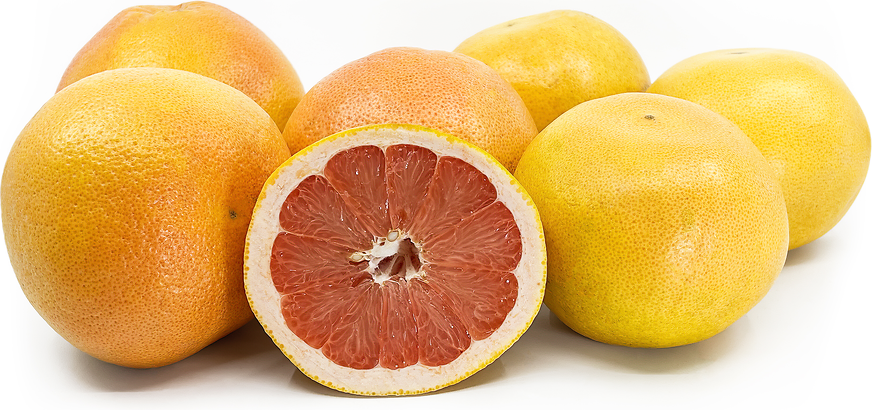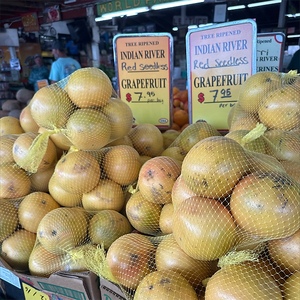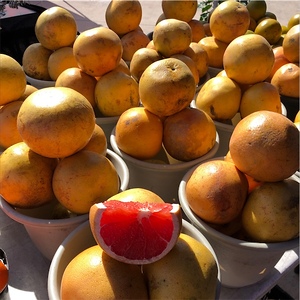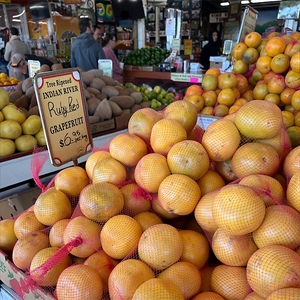


Indian River Grapefruit
Estimated Inventory, ea : 0
Description/Taste
Indian River grapefruits are medium to large fruits, averaging 10 to 15 centimeters in diameter, and have a plump, round to oblate shape. There are several varieties of grapefruits labeled as Indian River that may vary slightly in appearance, but the fruits generally have smooth, thin, and glossy skin, covered in prominent oil glands, giving the surface a pebbled texture. The peel also has a golden yellow-orange base when mature, sometimes blushed with light pink-red tones. Underneath the surface, there is a thin layer of white pith encasing 9 to 10 segments of flesh divided by white membranes. The seedless, red to pink flesh is comprised of fleshy vesicles, creating an aqueous, tender, and chewy consistency. Indian River grapefruits have high sugar content, contributing to the fruit’s sweet, subtly tart flavor. The grapefruits also contain fruity, floral undertones with subtly bitter, pleasant nuances.
Seasons/Availability
Indian River grapefruits are available in the winter through late spring.
Current Facts
Indian River grapefruits, botanically classified as Citrus paradisi, are fruits grown in a specific area of Florida belonging to the Rutaceae family. The Indian River Citrus District is an internationally recognized growing region situated along the southeastern coast of Florida. The district spans 200 miles of fertile land along the Atlantic Ocean and is known for its unique mixture of available water, warm weather, salty air, and soil. One of the district's unique qualities, besides its geological attributes, is that the region has mostly been unchanged since its establishment in the 1800s. Many of the orchards are still owned and operated by families, and the land has been cultivated without chemicals, preserving its natural feel. Grapefruits are one of the most popular types of citruses produced in the Indian River Citrus District, and there are several varieties grown, including Thompson Pink, Ruby Red, Flame, and White grapefruit. It has been reported that 70% of the grapefruit grown in the State of Florida is growing in the Indian River District, and the fresh fruits are sold domestically and shipped worldwide. Indian River grapefruits are heavily marketed as a fresh eating variety, valued for its high sugar and juice content, but the fruits can also be used in a wide array of sweet and savory culinary preparations.
Nutritional Value
Indian River grapefruits are an excellent source of vitamin C to strengthen the immune system while reducing inflammation and vitamin A to maintain healthy organ functioning. The grapefruits also provide fiber to regulate the digestive tract, potassium to balance fluid levels within the body, folate to develop red blood cells, and other nutrients, including magnesium, copper, B vitamins, zinc, iron, and thiamine. Red-fleshed varieties contain anthocyanins, pigments found in the flesh that contribute antioxidant-like properties to protect the cells against free radical damage.
Applications
Indian River grapefruits are prized for their sweet-tart flavor and juicy, tender nature, suited for fresh and cooked preparations. The grapefruits can be utilized in any recipes calling for grapefruits and are most commonly consumed straight, out of hand, discarding the peel. Indian River grapefruits can also be segmented and tossed into green salads, chopped into fruit bowls, diced into salsa, layered into parfaits, or sliced and stirred into grain-based dishes. Try cutting the fruits in half, broiling, and drizzling in honey to create a savory-sweet breakfast dish. The fruits have a tangy, sweet-tart juice that can be incorporated into sparkling beverages, fruit punches, cocktails, or blended into smoothies. In addition to fresh preparations, Indian River grapefruits can be juiced and used to flavor salad dressings, sauces, glazes, and sweet condiments such as jellies and jams. The grapefruits can also be infused into cakes, bars, muffins, tarts, meringue pies, and other desserts, including sorbet, popsicles, or custard. The fruit’s sweet flavor complements seafood dishes, and the peel is boiled and dusted in sugar to create a candied peel. Indian River grapefruits pair well with avocado, beets, bananas, apples, watermelons, pomegranate seeds, meats such as beef, poultry, and fish, spinach, fennel, kale, rosemary, and lime. Whole, unwashed Indian River grapefruits will keep up to one week at room temperature and for 3 to 4 weeks when stored in the refrigerator’s crisper drawer. Sliced grapefruit lasts for 3 to 4 days when kept in a plastic bag in the fridge.
Ethnic/Cultural Info
The Indian River Citrus District is unique from other citrus-growing regions in Florida for its coquina limestone-rich soil, available water resources, and extremely flat nature. Coquina limestone soil is a nutrient-rich blend of tiny particles of mollusk shells and other invertebrate shells from the ocean mixed with soil and sand, and the soil is filled with calcium and minerals to nurture citrus trees, sitting just above a layer of water in the ground sustains the roots. The location of the groves beside the coast also immerses the fruits in the salty humid air while maturing, developing added depth of flavor. The final element of the district that separates it from other growing regions is the land’s flat nature. Having flat groves allows farmers to flood the groves with a layer of water before a freeze arrives to protect the roots of the trees from freezing. The water acts as an insulator and will maintain the temperature of the grove about 2 to 4 degrees warmer than the air, a small but critical difference in the survival of the trees.
Geography/History
Citrus was introduced to the New World in the late 15th century, and oranges, in particular, were planted in St. Augustine, Florida, sometime between 1513 and 1565 through early Spanish explorers. The citrus groves were mainly planted around St. Augustine and Tampa, two famous seaports that could import seedlings and export fruit. Grapefruits were later brought to Florida from France by Count Odet Phillippe in 1806. Phillippe settled into Tampa Bay, where he is credited with planting the first grapefruit grove in 1823. While Count Odet Phillippe was growing grapefruits in Tampa, on the eastern coastline of Florida, Captain Douglas Dummitt settled onto the land that would eventually become the Indian River Citrus District in 1807. Experts documented that Dummitt was an explorer and was sailing the coast of Florida to find a place to build his house. Dummitt noticed that the air near the Indian River just north of Titusville was filled with the sweet and floral aroma of citrus. He decided to construct his homestead on the northern edge of Merritt Island beside the discovered groves, uprooting several citrus trees and planting them near his home. Over time, Dummitt continued to plant citrus varieties, including grapefruits, as the cultivars spread across Florida, and by the early 1900s, several other groves had been constructed around his property, forming the beginning of the Indian River Citrus District. Citrus grown in the region flourished in the early 1900s, and by 1920, it had become some of the most popular citrus found in the state. The Indian River District became a separate county in the 1920s and eventually expanded to include 200 miles of narrow land along the Florida coastline from Daytona Beach south to West Palm Beach, mapped according to specialized geological features and soil composition. Today Indian River grapefruits are grown throughout the coastal district and are sold domestically and internationally. The Indian River Citrus District is known for producing citrus exported to over 23 countries, including Japan, China, and countries in Europe. When in season, the citrus is found directly from growers, select retailers, and distributors.
Recipe Ideas
Recipes that include Indian River Grapefruit. One
| Jamie Geller |
|
Indian River Grapefruit Meringue Cake |











